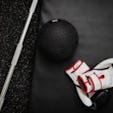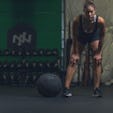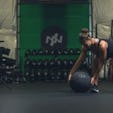You’ve got balls. Or at least one ball—a medicine ball—and you want to know all the ways you can use it, beyond the obvious stuff like throwing it into the floor and doing ab twists.
First thing’s first: you won’t lack for options. The medicine ball has been around for centuries—it may be the oldest training implement next to heavy rocks—and everyone from ancient Greek physicians to gladiators, soldiers, and today’s most elite trainers has contributed to its design and use.
It remains probably the simplest and most effective tool for training explosive power and rotational core strength, and anyone can use it. Welcome to Onnit’s Ultimate Guide to the medicine ball.
What Is It?
Not to be confused with the oversized, inflatable stability (or Swiss) ball, the medicine ball is a solid sphere that usually ranges in weight from one to 50 pounds. It can come in small sizes (like a softball) or larger ones, resembling a volleyball or beach ball.
The shell can be made from many materials, including nylon, vinyl, leather, dense rubber, or polyurethane, and the insides are often stuffed with sand, gel, or just inflated with air.
More traditional medicine balls have a tacky surface but newfangled models may offer grips that make them easier to simulate dumbbell and kettlebell exercises. Some balls come with a rope attached so you can swing them.
Details aside, medicine balls break down into two categories—ones that bounce on impact and ones that don’t. Laura Williams, manager of the online health and fitness community GirlsGoneSporty.com, calls them “live and dead balls—which I know sounds like some sort of dirty joke.”
Balls with a hard shell and air inside will rebound when you throw them into a wall or the floor, making them helpful for exercises in which you want the ball to return to your hands quickly (such as med ball slams on the floor). In contrast, “dead balls don’t bounce,” says Williams. “Maybe that’s the punchline?”
Typically, dead balls have a softer exterior of stitched material, which makes them a good all-purpose option that tends to be more durable.
What It Does (Benefits)
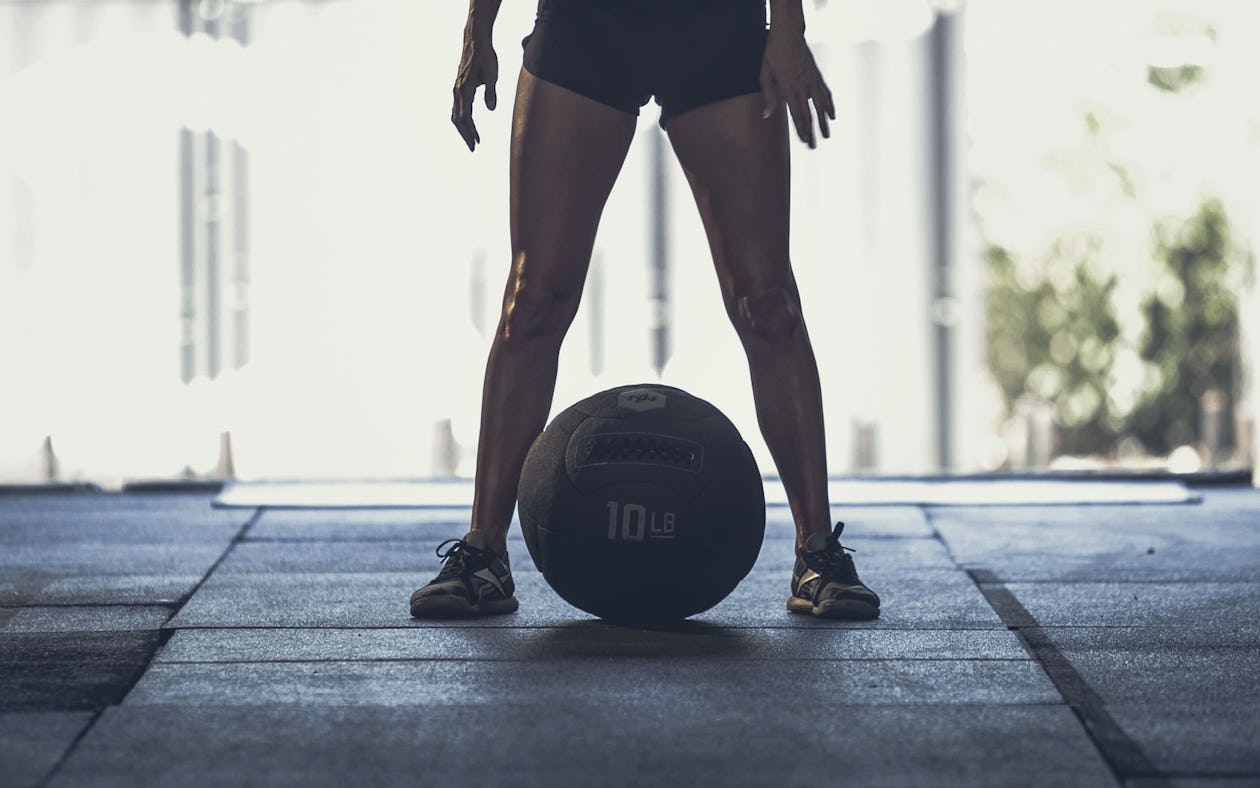
In a word, power. Medicine balls are mainly used for throwing and catching drills, which build explosivity and the ability to absorb and redirect force—all of which are crucial to athletes.
Lifting barbells and dumbbells builds strength, which lays the foundation for power, but according to the American College of Sports Medicine, it doesn’t develop explosivity as well as medicine ball training does.
Imagine doing a bench press with light weight and pushing the bar as fast as you can. Even though you’re training your body to move the bar faster, your muscles still have to decelerate the movement at the top of the lift to prevent injury to your shoulders and elbows, not to mention to prevent the bar from flying out of your hands.
That means you never really maximize your ability to explode as much as possible.
“The medicine ball teaches you to let go,” says Sam Pogue, creator of the Be Less Un-Fit Program (sampogue.com). Because you can throw the ball, you don’t have to worry about slowing it down for safety. Just chuck the sumbitch.
Your nervous system will fire your muscles harder, which translates to harder punches, faster baseball bat swings and pitches, and a more powerful bench press too. It works the same way plyometric exercises like jumps do for the lower body.
Furthermore, Pogue says the med ball gives you instant feedback on your power. “It’s the difference between taking a practice swing with a bat and actually hitting a baseball. If I just swing, I don’t really know how hard I swung it.
But if I connect and see how far the ball goes, I do.” When you use a medicine ball, you can gauge your power by how far you can launch it.
“There is a freedom of movement with many dynamic medicine ball exercises that replicates the movement found in many sports,” says Doug Fioranelli, a strength coach and owner of Rise Above Performance Training in Belmont, Calif. “That’s not necessarily found in other strength training exercises.
The foundational movements like squats, deadlifts and bench press are great for building strength but are limited by their single plane of movement and ability to transfer power throughout the whole body.”
Using a ball, you can project power in every plane of motion—front to back, side to side, and in rotation. With free weights and machines, your options for training your core to twist, and resist twisting, are limited.
But medicine balls allow for natural rotational motions that can help define your midsection as well as prevent injury to the lower back.
But what about the Olympic lifts? Don’t snatches and cleans and their many variants build power and athleticism like nothing else?
For most athletes, particularly young ones and novices, learning the Olympic lifts requires so much time to learn proper technique that many coaches don’t bother with them anymore.
“In my opinion, med balls are a better alternative to Olympic lifting,” says Buddy Morris, strength coach for the NFL’s Arizona Cardinals. “Especially when you look at the learning curve of a large group of athletes. Olympic lifting is a great sport in itself, but is only one of many methods for power/speed development in athletes.” On the other hand, anybody can learn to use a medicine ball in no time.
Unlike free weights, med balls are undeniably safe, making them a must-have if you train alone in a home gym. Even if you drop a heavy one directly on your toes you won’t get injured, or damage your floor, and a med ball takes up considerably less space than a power rack or wall-length set of dumbbells.
Finally, there’s the fun factor. Fioranelli adds that, “I am hard pressed to find someone, young or old, who does not like tossing medicine balls. When the athlete is having fun, they will feel good and focus more on what they are doing.”
What The Research Says
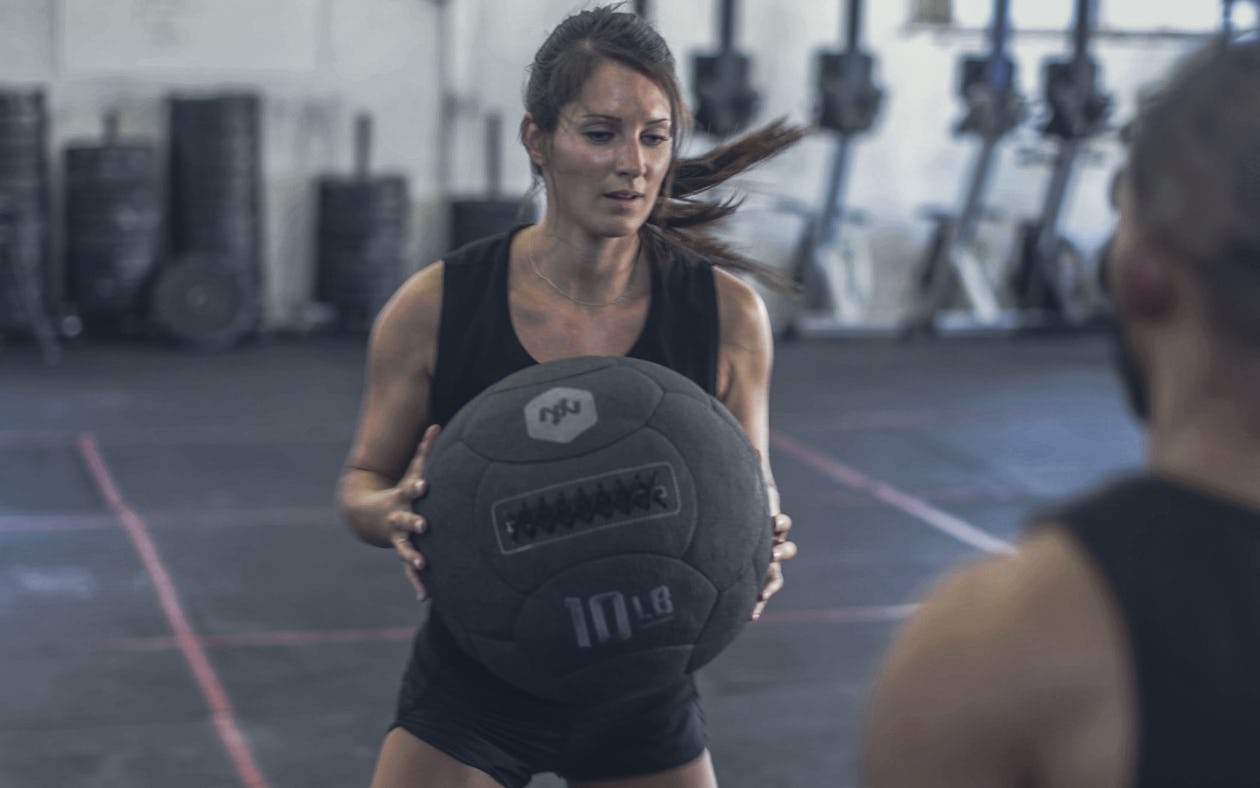
A 2012 study in the Journal of Strength and Conditioning Research looked at female handball players who either trained with medicine balls in addition to their regular season training or did only their conventional training alone.
Both groups significantly improved their one-rep max in the bench press and overhead press, but the med ball group made significantly greater gains on throw tests as well as bench and shoulder pressing power.
The researchers determined that the use of medicine balls can provide greater sport-specific training improvements in the upper body.
In 2015, a similar study of elite male handball players found that the medicine ball users improved their throwing velocity, muscle volume, max upper-body strength, and power over an eight week in-season period.
6 Ways To Use a Medicine Ball

The medicine ball may be most noteworthy for its use in power development, but the number of ways you can train with it are limited only by your creativity. Below are the main examples.
1. Throw it.
Toss the ball into a wall with feet shoulder-width apart or in a fighting stance/batter’s stance. Use one or both hands. You can also perform throws from your knees, on your back, or while jumping.
2. Catch it.
Throw the ball into a wall and catch it when it rebounds, or toss it back and forth with a partner as if playing catch.
3. Lift it.
No dumbbells handy? You can use even a light med ball as a weight. Set up a circuit and squat with it, press it overhead, and perform lunges, rows, and ab twists or woodchops.
Hold it on one side of your body to challenge your core with an off-set load, or hold it in one palm and do Turkish getups as you would with a kettlebell. Want to train like the World’s Strongest Man? Carry it in your arms or overhead for distance or time.
4. Balance on it.
You can use a med ball as an apparatus. Place one or both hands on it and do pushups to challenge your stability. Rest your feet on it and bridge your hips off the floor to work your glutes. Sometimes you don’t have to even touch the ball—treat it like a hurdle and jump over it.
5. Roll on it.
Foam rollers aren’t the only tool you can use to warm up and increase mobility. Roll your muscles out on the ball. For particularly tender areas, even a soft-shell med ball can provide enough density to release tight muscles.
6. Use it for feedback.
The ball can act as a spotter. Place it behind you when you squat so you know when you’ve gone deep enough, or use it to block you from going too deep if you have a lower back or hip injury.
For ladies who want to tone their inner thighs, they can squeeze the ball between their knees on various lower-body exercises to ensure constant engagement.
As Pogue mentioned above, the medicine ball can provide instant feedback on your power levels on any particular day, so you can use it to determine your readiness to train. When you get to the gym, try throwing the med ball for distance.
Once you’ve established a baseline after a few workouts, you can measure how far you throw the ball in every session and make comparisons. If your power is down one day, you may want to ease up on any heavy lifting you do in that session (i.e., don’t max out your bench press).
Another use: customizing your rest periods. “If you throw the ball 30 feet, and then 30 seconds later you throw it 25 feet, you know you didn’t give yourself enough recovery,” says Pogue. “If you rest three minutes and then you throw it 35 feet, now you know how much rest you need for power.”
Finally, the med ball can help you key up your central nervous system for a better strength workout. Performing throws against a wall or overhead, or slams into the floor, before you do any heavy pressing can help your brain “turn on” more muscle fibers for the effort.
Training Tips
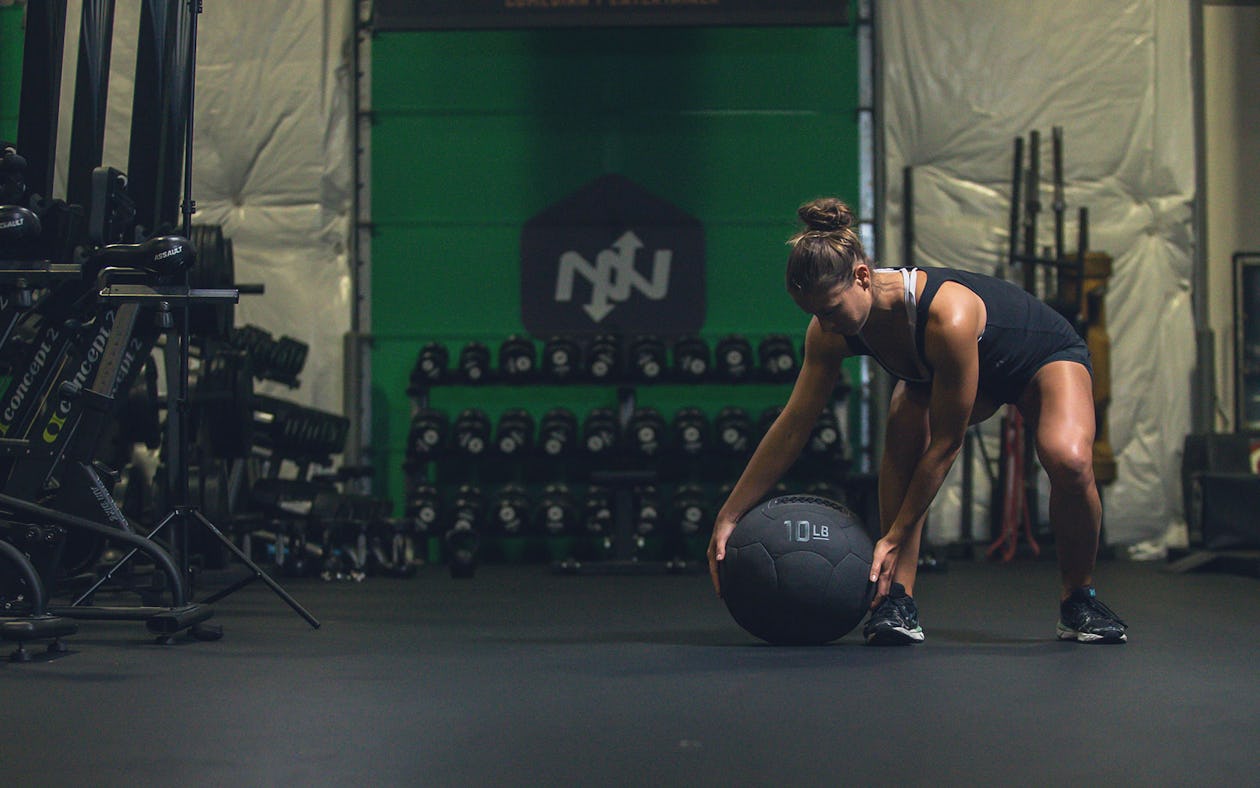
In general, when the goal is power, med ball exercises should be done for low reps to preserve maximum speed and good technique. Pogue recommends 3–5 sets of 2–3 reps with rests of 2–3 minutes for exercises such as throws. Don’t go to failure on any set.
As for how heavy the ball should be, the ideal weight is one that allows you to feel resistance but doesn’t force you to change the mechanics of the exercise, so err on the side of going too light and stop any set when you feel your speed is beginning to suffer or your form is about to break down. “I’d get a 10-pound ball if you’re a man, five to eight pounds for a woman,” says Pogue.
That will provide enough resistance to cover the broadest range of exercises for most people.
For ab training or other work where you use the ball just for load, you can do sets for time. “If you want to get a cardio benefit or just sweat and move,” says Pogue, “do 3–5 sets of slams for 30 seconds straight. Rest under a minute between sets.”
The History of Balls (Go Ahead and Laugh)
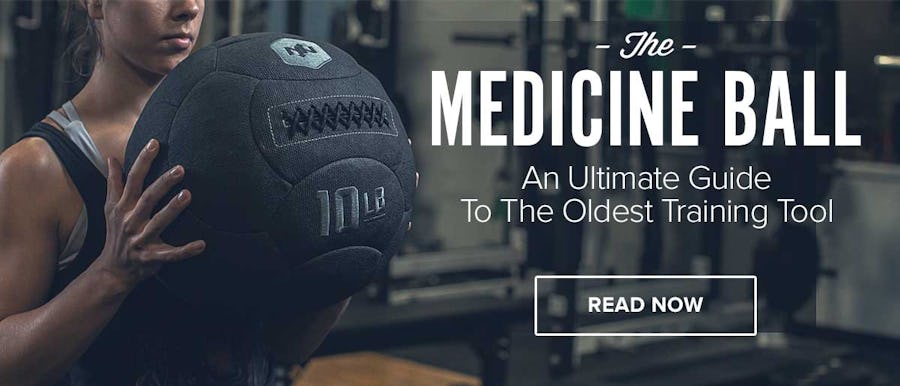
It’s hard to say exactly where and when medicine balls were born, but ancient drawings suggest Persian warriors trained with animal bladders filled with sand 3,000 years ago, and the Greek physician Hippocrates was rumored to have stuffed animal skins for his patients to toss around for exercise.
Before modern-day gym workouts, physical activity of almost any kind was considered a form of medicine for curing ailments. An article published in Scientific American in 1889 attributes the name “medicine ball” to a Professor Robert Roberts, a fitness authority of the day.
The article declared that “playful exercise with [the medicine ball] invigorates the body, promotes digestion, and restores and preserves one’s health¦As the ball rests on the floor, it is the most natural of all things for a man to come along and kick it or lift it on his toe, and throw it up in the air, thus developing the muscles of the legs and abdomen.”
More than 100 years later, not much has changed.
How to Choose a Ball
The best ball for you depends on what you want to use it for. “If you plan on just doing some ab exercises, tossing it back and forth, or doing stationary exercises like squats and presses, any material is going to be fine,” says Pogue. “If you’re going to slam it on the ground or against walls, you’re going to want something more durable.”
Rubber balls, he warns, have an end life. Months of abuse can cause them to crack or lose shape, affecting their rebound ability and potentially even causing leaks.
“Your medicine ball should be made with a sturdy material, like Kevlar®, so it won’t change shape over time,” says Pogue. A tacky surface is also a plus, as it ensures a strong grip even when your palms are sweaty.
Medicine-Ball Workouts
See our medicine-ball workouts for more.
References
1. American College of Sports Medicine.
https://www.acsm.org/docs/brochures/selecting-and-effectively-using-a-medicine-ball.pdf?sfvrsn=2
2. Scientific American Supplement, No. 689.
https://babel.hathitrust.org/cgi/pt?id=coo.31924071607323;view=1up;seq=181
3. Effects of 12-week medicine ball training on muscle strength and power in young female handball players.
https://www.ncbi.nlm.nih.gov/pubmed/22027860
4. Comparison of In-Season-Specific Resistance vs. A Regular Throwing Training Program on Throwing Velocity, Anthropometry, and Power Performance in Elite Handball Players.
https://www.ncbi.nlm.nih.gov/pubmed/25627646
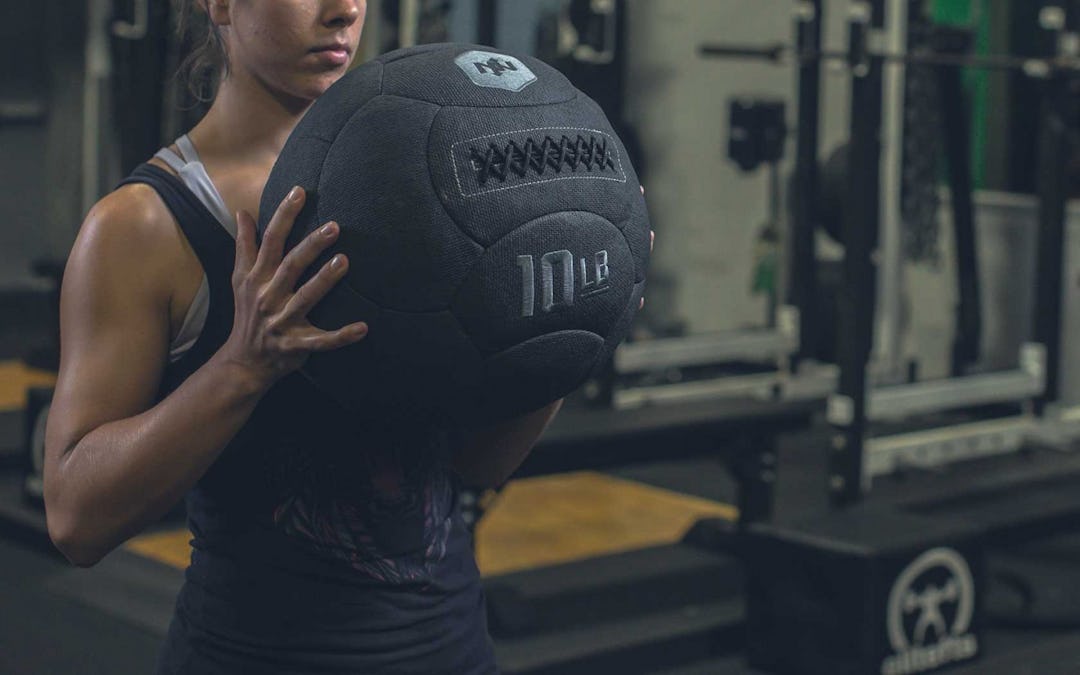
)
